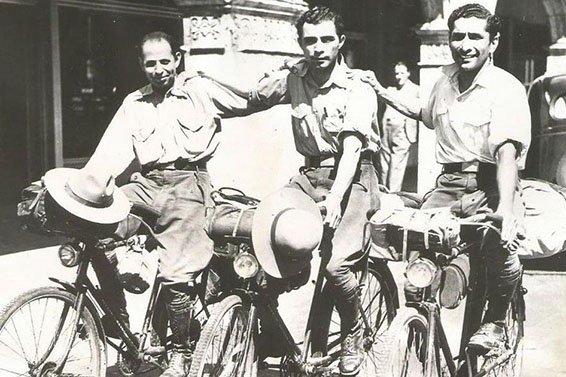The incredible adventures of seven Parsi men who cycled across the world nearly a century ago
Through resourcefulness and strength, the men from Bombay overcame all kinds of obstacles and hardships.
“I envy the young men who have made the book. I too have some of the red blood which seeks adventure; some thing of the wanderlust which even drives one forward. But fate and circumstances have prevented from satisfying it in the ordinary way – I seek adventure in other ways.”
Jawaharlal Nehru’s foreword to a book by three Parsi men who cycled around the world in the 1920s was just one of the delightful things about it. Chapter after chapter in the book describes the young men’s rollicking adventures, like the time one of them got stones broken on his chest with a hammer while another dragged a car with a rope held between his teeth.
Anoop Babani read the book, With Cyclists Around The World, with amusement and interest, but it was the end that intrigued the former journalist and cyclist. There, on “perhaps the last page”, was the hope that the grand reception received by the three Parsis upon their return to Bombay in March 1928 would also be accorded to “another fellow who is coming back”. Who was this fellow? When did he leave India and when did he come back? Babani had to find out.
His research revealed that in the 1920s and 1930s, 10 Indians – all in their 20s, all Parsis, and all from Bombay – chose to cycle around the globe in three separate groups. “Fired by the intense desire to carry the name of the country – Mother India – to the far-flung corners of the world,” they journeyed across mountains, forests and plains, sometimes without food and water. Eventually, only seven of them completed their odyssey.
How it began
The first group to set off on their bicycles was made up of six members of the Bombay Weightlifting Club. They were Adi Hakim, Jal Bapasola, Rustom Bhumgara, Gustad Hathiram, Keki Pochkhanawala and Nariman Kapadia. According to Rohinton Bhumgara, son of Rustom Bhumgara, the six youngsters had attended a public lecture in 1920 by a Frenchman who had walked from Europe to India. Hearing him talk left them deeply inspired.
Their journey began in October 1923 and meandered through Punjab, Balochistan, the Middle East, Europe, United States, Japan and South East Asia. On the way, one team member returned to India from Tehran for “personal reasons”, while two others were so “enamoured” of America that they stayed back.

“Once, he [Jal Bapasola] narrated how they approached the Raleigh Cycle Co of England in Bombay about [the company] sponsoring the cycles,” Babani was told by Bapasola’s 82-year-old son Noshir Bapasola, who lives in New Jersey. “The company refused. “But when they reached England, he said the company was begging them to use their cycles. He asked them why they had a change of heart and was told quite bluntly ‘we did not believe that you boys would be so successful’.”
By the time Hakim, Bapasola and Bhumgara reached India in March 1928, they had covered around 70,000 kilometres. In their book With Cyclists Around The World, they enumerated their achievements with “pardonable pride”: in four and a half years, they had scaled the Alps, crossed “pirate-infested territories” and waded through jungles with “hostile semi-savage tribes”, sometimes “escaping death by inches”.
Overcoming hardships
Their efforts, in turn, inspired a sports journalist from Bombay named Framroze Davar to set off on his bicycle, all on his own. Nine months and 5,000 kilometres later, in Vienna, “he met Gustav Sztavjanik, [a cyclist] who was impressed with his journey,” said Babani. “He joined Davar and they both cycled around the world for seven years. Theirs was the longest, toughest and most adventurous journey.”
According to Babani, their hardships knew no end. They faced eight sandstorms and ran out of water. The terrain was so thorny that they had to stuff their tyres with grass. They even contracted malaria. The biggest challenge for them, though, was the Amazon. Struggling to cycle in the thick forest, they were forced to build rafts. Thankfully for them, a tribe of head-hunters gave them shelter. “It was their first such trip ever from the West coast to the East coast of South America and took them about nine months,” wrote Austrian author Hermann Härtel in a book on Sztavjanik. “This was uncharted territory and very dangerous. Many explorers before them never made it back out again.”

When the two reached Burma, they found themselves amidst a herd of wild elephants. Sztavjanik was injured and hospitalised for a month. Davar, who covered a total of 10,000 kilometres, 52 countries and five continents, wrote three books on his travels: Cycling Over Roof Of The World, Across The Sahara and The Amazon in Reality and Romance. “These books are a great study in anthropology,” said Babani. In them, Davar talks about the tribes he meet in the Amazon, “their customs, how they look, their clothing and what they hunt”.
Stories of these adventures inspired a third group of Parsi men – Keki Kharas, Rustam Ghandhi and Rutton Shroff – to cycle around the world in 1933. After covering 84,000 kilometres spanning five continents over nine years, they co-authored two books: Pedaling Through The Afghan Wildsand Across The Highways Of The World. In the first, they wrote, “In Afghanistan, we were marooned in the desert for three successive days and nights without either food or water….”










